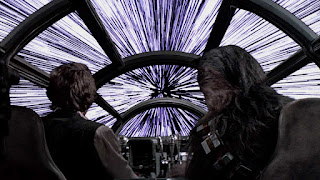This is one of those pet peeves where I swear some youtube scientists were explaining it incorrectly (in a hurry or something). Basically, no you can't just keep using relative velocity to keep throwing something faster till you go past the speed of light.
Well, they don't explain how the universe is expanding faster than the speed of light and that part of it... but just read this:
https://bigthink.com/starts-with-a-bang/alien-space-travel-speed-of-light/
In fact, if you accelerated constantly, at 9.8 m/s², toward any distant astronomical object, you’d find that you never quite reached the speed of light, but only approached it from below. You’d find that you still continued to move faster and faster, and that your destination continued to get closer and closer (and also, the light from it would appear more and more blueshifted as you achieved increasingly greater speeds), but that every photon you emitted still:
- moved at the speed of light, relative to you,
- moved at the speed of light, relative to your source and your destination (and everyone else),
- and received only a change in wavelength, not speed, because of your motion when you emitted it.
However, two things would change dramatically for you on your relativistic (i.e., close to the speed of light) journey: the way you experienced both distances and times relative to someone who remained at rest, either at the source, the destination, or at any other point along your journey.
- Distances, rather than being fixed between any two points, would be observed to contract along your direction of motion. This phenomenon of length contraction was named after the scientists George FitzGerald and Hendrik Lorentz, who first understood this even before Einstein’s special relativity came along.
- Time, rather than appearing to pass at the same rate for everyone everywhere, is instead relative, with time being observed to dilate between the space traveler in motion relative to the origin and the destination, where clocks appear to run slower for the observer in motion relative to the stationary ones.
While someone who remained at the same location they started at, such as the origin point or the destination point, would continue to age as normal, someone who traveled through a significant amount of space during that same interval would experience a shorter passage of time, and the amount that it was shorter by would depend entirely on how close they made it to the speed of light during their journey. The faster you go, the less amount of time passes for you, the traveler, but as measured by an observer at either the source or destination, at least as much time that it would take a light ray to travel from here-to-there is required for a spacefaring traveler to traverse the same distance.
Complete sidenote, among others, these guys that laid the groundwork before Einstein were from Ireland and the Netherlands.
George FitzGerland from Ireland. Wikip says: Father was a reverend. FitzGerald is known for his work in electromagnetic theory and for the Lorentz–FitzGerald contraction, which became an integral part of Albert Einstein's special theory of relativity.
Hendrik Lorentz from the Netherlands. -> wikipedia says, he wasn't a straight C student like Einstein, instead: Dad was a horticulturist (a well-off one) and... His results in school were exemplary; not only did he excel in the physical sciences and mathematics, but also in English, French, and German. In 1870, he passed the exams in classical languages which were then required for admission to University.
Pieter Zeeman from the Netherlands. Wikip says: father was a religious dude also, a minister. Pieter became interested in physics at an early age. In 1883, the aurora borealis happened to be visible in the Netherlands. Zeeman, then a student at the high school in Zierikzee, made a drawing and description of the phenomenon and submitted it to Nature, where it was published. The editor praised "the careful observations of Professor Zeeman from his observatory in Zonnemaire". ... .... "He discovered that a spectral line is split into several components in the presence of a magnetic field."
Another interesting dude:
James Clerk Maxwell FRSE FRS (13 June 1831 – 5 November 1879) was a Scottish physicist with broad interests[1][2] who was responsible for the classical theory of electromagnetic radiation, which was the first theory to describe electricity, magnetism and light as different manifestations of the same phenomenon. Maxwell's equations for electromagnetism have been called the "second great unification in physics"[3] where the first one had been realised by Isaac Newton.
...
His discoveries helped usher in the era of modern physics, laying the foundation for such fields as special relativity and quantum mechanics. Many physicists regard Maxwell as the 19th-century scientist having the greatest influence on 20th-century physics. His contributions to the science are considered by many to be of the same magnitude as those of Isaac Newton and Albert Einstein.[11]


No comments:
Post a Comment